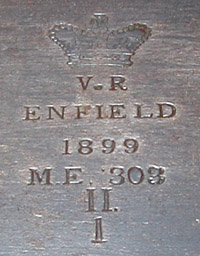1. The Sovereign's, or
Royal Cypher. Military Martini-Henrys will bear the
Queen's Cypher, accompanied by Victoria's initials, "V.R."
for "Victoria Regina" (Latin for "Queen Victoria"). After
Victoria's death in 1901, the throne was assumed by King
Edward VII and King George V. Martinis manufactured, or
converted to .303 after Victoria's death will bear a
Sovereign's Cypher with a King's, or Tudor Crown, and the
initials E.R. or G.R. (for "Edward Rex" or "George
Rex"..."Rex" being Latin for "King"). 2. Manufacturer's Code.
The maker of the weapon. There were six makers of
British Military Martini-Henrys... BE Co. - Blenheim
Engineering Company Ltd. BSA & M Co. -
Birmingham Small Arms & Metal Company
Ltd. ENFIELD - The Royal Small
Arms Factory (RSAF) at Enfield Lock HRB Co. - Henry Rifled
Barrel, Engineering and Small Arms Company
Ltd. LSA Co. - London Small
Arms Company Ltd. NA & A Co. - National
Arms and Ammunition Company Ltd. 3. Year of Manufacture.
The year in which the weapon was built. A work year ran
from April, 1 to March, 31 of the following year. Sometimes,
the fourth digit in the date code will be seen engraved
instead of stamped, and sometimes stamped off center in
comparison to the other three digits of the year. 4. Lock Viewer's Mark.
In the time of muzzle loading weapons, this marking was
applied to indicate that a Lock Viewer, or an inspector
specializing in rifle locks had inspected the lock for
correct function, and adherence to the specified pattern. It
served the same purpose on Martinis, the internals of the
action body being the "Lock". This marking was found to be
superfluous, and was not applied to weapons dated 1898 or
later. Each manufacturer had minor variations in their Lock
Viewer's Mark. These markings are detailed on the Lock
Viewer's
Mark Page.
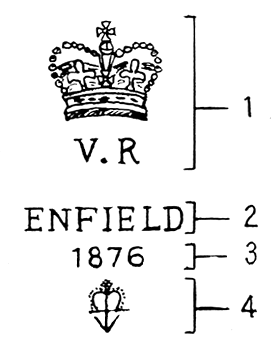
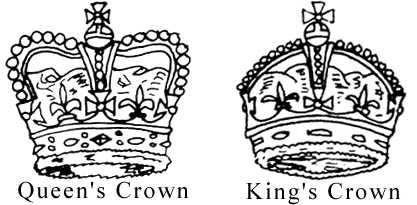
Class of
Arm... Another marking of note on
the Sovereign's Cypher side of the action body is the "Class
of Arm" marking. Martini-Henry's were placed in two classes.
First Class Arms were frontline, current pattern weapons.
Second Class Arms were those of obsolete patterns, examples
with more wear, or weapons thought to be generally less
"frontline ready". As you can see by this Martini-Henry Mark
III Infantry Rifle's markings, it was a First Class Arm.
Second Class Arms were often sent to training units, or home
guard/militia units. Note the small cocking indicator,
characteristic of this pattern Martini.
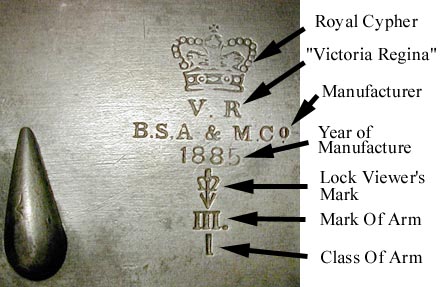
Mark of
Arm... An example Sovereign's
Cypher from a Martini-Henry Mark II Infantry Rifle. Directly
below the Lock Viewer's Mark is the "Mark of Arm" marking.
In this case, the Roman Numeral "II". Often times there will
be a "." following the last digit. This is sometimes
referred to as a "stop". Sometimes when a weapon was
upgraded to a later Mark, this marking will be modified to
suit. This is easily identifiable by added characters being
struck deeper, lighter, off center, or a combination of
these. Here's an example of an
"off-center" character. Notice how the second "I" in the
Mark of Arm marking is off center. This rifle started life
as a Martini-Henry Mark I Infantry Rifle. At some point, the
weapon was upgraded to the Mark II Pattern, and an
additional "I" was applied to the right of the
original.
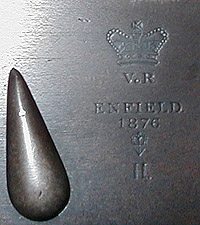
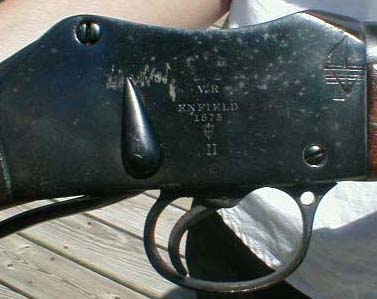
The Conversion
Cypher... The left side of the action
body on a Martini-Enfield. Typically, any Martini-Henry
converted to .303 caliber will indicate the year of
conversion and other particulars about the conversion here
on the conversion cypher. "1899" is the year this weapon was
converted to a Martini-Enfield. "M.E. 303" indicates that
the weapon was converted to a Martini-Enfield. A .303
caliber barrel with Enfield pattern rifling was fitted, and
thus was born a Martini-Enfield. "M.M." would indicate a
barrel with William Metford's pattern of rifling had been
installed, thus producing a Martini-Metford. The "II"
indicates the weapon was converted to a Martini-Enfield Mark
II pattern, and "I" indicates the weapon is a "First Class"
weapon. Notice the absence of a lock viewer's mark, as the
conversion was done post 1897.
